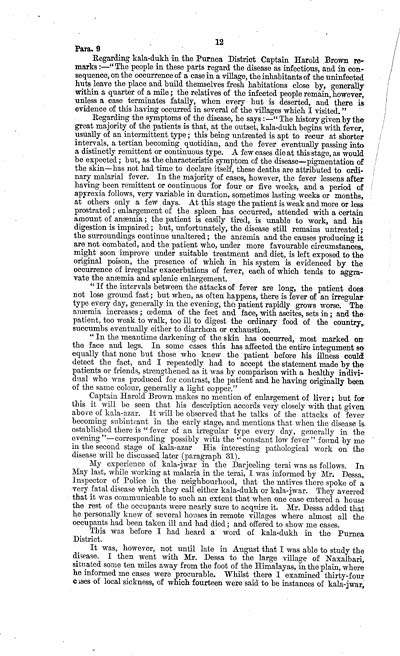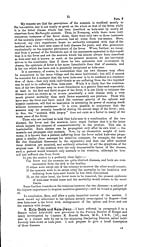Medicine - Disease > Report on the nature of kala-azar
(20) Page 12
Download files
Individual page:
Thumbnail gallery: Grid view | List view

12
Para. 9
Regarding kala-dukh in the Purnea District Captain Harold Brown re-
marks:-"The people in these parts regard the disease as infectious, and in con-
sequence, on the occurrence of a case in a village, the inhabitants of the uninfected
huts leave the place and build themselves fresh habitations close by, generally
within a quarter of a mile; the relatives of the infected people remain, however,
unless a case terminates fatally, when every hut is deserted, and there is
evidence of this having occurred in several of the villages which I visited. "
Regarding the symptoms of the disease, he says :-"The history given by the
great majority of the patients is that, at the outset, kala-dukh begins with fever,
usually of an intermittent type; this being untreated is apt to recur at shorter
intervals, a tertian becoming quotidian, and the fever eventually passing into
a distinctly remittent or continuous type. A few cases die at this stage, as would
be expected; but, as the characteristic symptom of the disease-pigmentation of
the skin-has not had time to declare itself, these deaths are attributed to ordi-
nary malarial fever. In the majority of cases, however, the fever lessens after
having been remittent or continuous for four or five weeks, and a period of
apyrexia follows, very variable in duration, sometimes lasting weeks or months,
at others only a few days. At this stage the patient is weak and more or less
prostrated; enlargement of the spleen has occurred, attended with a certain
amount of anmia; the patient is easily tired, is unable to work, and his
digestion is impaired; but, unfortunately, the disease still remains untreated ;
the surroundings continue unaltered; the anmia and the causes producing it
are not combated, and the patient who, under more favourable circumstances,
might soon improve under suitable treatment and diet, is left exposed to the
original poison, the presence of which in his system is evidenced by the
occurrence of irregular exacerbations of fever, each of which tends to aggra-
vate the anmia and splenic enlargement.
" If the intervals between the attacks of fever are long, the patient does
not lose ground fast; but when, as often happens, there is fever of an irregular
type every day, generally in the evening, the patient rapidly grows worse. The
anmia increases; dema of the feet and face, with ascites, sets in; and the
patient, too weak to walk, too ill to digest the ordinary food of the country,
succumbs eventually either to diarrha or exhaustion.
"In the meantime darkening of the skin has occurred, most marked on
the face and legs. In some cases this has affected the entire integument so
equally that none but those who knew the patient before his illness could
detect the fact, and I repeatedly had to accept the statement made by the
patients or friends, strengthened as it was by comparison with a healthy indivi-
dual who was produced for contrast, the patient and he having originally been
of the same colour, generally a light copper."
Captain Harold Brown makes no mention of enlargement of liver; but for
this it will be seen that his description accords very closely with that given
above of kala-azar. It will be observed that he talks of the attacks of fever
becoming subintrant in the early stage, and mentions that when the disease is
establishecl there is " fever of an irregular type every day, generally in the
evening"-corresponding possibly with the "constant low fever" found by me
in the second stage of kala-azar His interesting pathological work on the
disease will be discussed later (paragraph 31).
My experience of kala-jwar in the Darjeeling terai was as follows. In
May last, while working at malaria in the terai, I was informed by Mr. Dessa,
Inspector of Police in the neighbourhood, that the natives there spoke of a
very fatal disease which they call either kala-dukh or kala-jwar. They averred
that it was communicable to such an extent that when one case entered a house
the rest of the occupants were nearly sure to acquire it. Mr. Dessa added that
he personally knew of several houses in remote villages where almost all the
occupants had been taken ill and had died; and offered to show me cases.
This was before I had heard a word of kala-dukh in the Purnea
District.
It was, however, not until late in August that I was able to study the
disease. I then went with Mr. Dessa to the large village of Naxalbari,
situated some ten miles away from the foot of the Himalayas, in the plain, where
he informed me cases were procurable. Whilst there I examined thirty-four
cases of local sickness, of which fourteen were said to be instances of kala-jwar,
Para. 9
Regarding kala-dukh in the Purnea District Captain Harold Brown re-
marks:-"The people in these parts regard the disease as infectious, and in con-
sequence, on the occurrence of a case in a village, the inhabitants of the uninfected
huts leave the place and build themselves fresh habitations close by, generally
within a quarter of a mile; the relatives of the infected people remain, however,
unless a case terminates fatally, when every hut is deserted, and there is
evidence of this having occurred in several of the villages which I visited. "
Regarding the symptoms of the disease, he says :-"The history given by the
great majority of the patients is that, at the outset, kala-dukh begins with fever,
usually of an intermittent type; this being untreated is apt to recur at shorter
intervals, a tertian becoming quotidian, and the fever eventually passing into
a distinctly remittent or continuous type. A few cases die at this stage, as would
be expected; but, as the characteristic symptom of the disease-pigmentation of
the skin-has not had time to declare itself, these deaths are attributed to ordi-
nary malarial fever. In the majority of cases, however, the fever lessens after
having been remittent or continuous for four or five weeks, and a period of
apyrexia follows, very variable in duration, sometimes lasting weeks or months,
at others only a few days. At this stage the patient is weak and more or less
prostrated; enlargement of the spleen has occurred, attended with a certain
amount of anmia; the patient is easily tired, is unable to work, and his
digestion is impaired; but, unfortunately, the disease still remains untreated ;
the surroundings continue unaltered; the anmia and the causes producing it
are not combated, and the patient who, under more favourable circumstances,
might soon improve under suitable treatment and diet, is left exposed to the
original poison, the presence of which in his system is evidenced by the
occurrence of irregular exacerbations of fever, each of which tends to aggra-
vate the anmia and splenic enlargement.
" If the intervals between the attacks of fever are long, the patient does
not lose ground fast; but when, as often happens, there is fever of an irregular
type every day, generally in the evening, the patient rapidly grows worse. The
anmia increases; dema of the feet and face, with ascites, sets in; and the
patient, too weak to walk, too ill to digest the ordinary food of the country,
succumbs eventually either to diarrha or exhaustion.
"In the meantime darkening of the skin has occurred, most marked on
the face and legs. In some cases this has affected the entire integument so
equally that none but those who knew the patient before his illness could
detect the fact, and I repeatedly had to accept the statement made by the
patients or friends, strengthened as it was by comparison with a healthy indivi-
dual who was produced for contrast, the patient and he having originally been
of the same colour, generally a light copper."
Captain Harold Brown makes no mention of enlargement of liver; but for
this it will be seen that his description accords very closely with that given
above of kala-azar. It will be observed that he talks of the attacks of fever
becoming subintrant in the early stage, and mentions that when the disease is
establishecl there is " fever of an irregular type every day, generally in the
evening"-corresponding possibly with the "constant low fever" found by me
in the second stage of kala-azar His interesting pathological work on the
disease will be discussed later (paragraph 31).
My experience of kala-jwar in the Darjeeling terai was as follows. In
May last, while working at malaria in the terai, I was informed by Mr. Dessa,
Inspector of Police in the neighbourhood, that the natives there spoke of a
very fatal disease which they call either kala-dukh or kala-jwar. They averred
that it was communicable to such an extent that when one case entered a house
the rest of the occupants were nearly sure to acquire it. Mr. Dessa added that
he personally knew of several houses in remote villages where almost all the
occupants had been taken ill and had died; and offered to show me cases.
This was before I had heard a word of kala-dukh in the Purnea
District.
It was, however, not until late in August that I was able to study the
disease. I then went with Mr. Dessa to the large village of Naxalbari,
situated some ten miles away from the foot of the Himalayas, in the plain, where
he informed me cases were procurable. Whilst there I examined thirty-four
cases of local sickness, of which fourteen were said to be instances of kala-jwar,
Set display mode to: Large image | Zoom image | Transcription
Images and transcriptions on this page, including medium image downloads, may be used under the Creative Commons Attribution 4.0 International Licence unless otherwise stated. ![]()
| India Papers > Medicine - Disease > Report on the nature of kala-azar > (20) Page 12 |
|---|
| Permanent URL | https://digital.nls.uk/74580944 |
|---|




